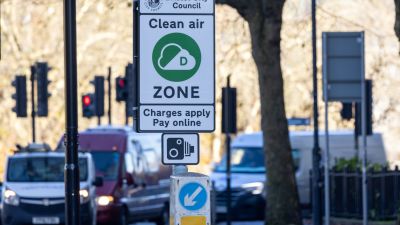'We are on track' - report says Bristol Clean Air Zone is working one year on

A report looking at Bristol's Clean Air Zone suggests that clean air is being delivered in the city, one year since it launched.
The work by the Joint Air Quality Unit (JAQU) says data indicates that air quality in the city will not exceed the Government’s average annual legal limit this year.
What is the Clean Air Zone?
The Clean Air Zone was started with the aim of reducing harmful pollution from road traffic.
The government set legal limits for air pollution and Bristol City Council set up the scheme to try and reduce pollution levels to within those limits.
Air pollution, such as nitrogen dioxide, is harmful to human health and particularly affects children, older people and people with heart or lung conditions.
A major source of pollution is cars, vans, lorries and buses, especially those with diesel engines.
The daily charge to enter the zone area only affects drivers of the dirtiest, most polluting vehicles.
The idea is to deter drivers from polluting the area in a large area around the centre of Bristol, and encourage them to switch to less polluting vehicles.
All the cash raised from the scheme will be spent on operating the Clean Air Zone and improving transport infrastructure around Bristol, including on bus services and cycle routes.
It’s unclear how much money the council has raised, but it’s expected to be over £9 million.
The scheme has proved controversial, with some people being charged despite not having driven through.
Charities have also spoken out about the cost of driving through the city to them.
There are exemptions for some driving into the zone with non-compliant vehicles but charities do not qualify for an exemption by default.
In August 2023 it was also revealed that fewer than one in five motorists who challenge a Clean Air Zone fine from Bristol City Council lose their case if they take it to appeal.
Marvin Rees, Mayor of Bristol, said: “The Clean Air Zone, mandated by national government, was never about generating income, it was about delivering cleaner air to secure a healthier future for Bristol.
“A year after the start of the Clean Air Zone, this report from the Joint Air Quality Unit demonstrates that we are on track.
“Thousands of people have taken up some of the £42m funding support we secured for Bristol, and 82% of cars are now compliant.
“Residents across our city have accessed 25,000 travel offers, including bus tickets, cycle training, bike loans, and car club vouchers.
“However, we still have a significant amount of financial support available for individuals and businesses, and so I encourage everyone to have a look and see if you’re eligible.”
Christina Gray, Director of Communities and Public Health, said: “These early results from Bristol’s Clean Air Zone are a positive indication that we are heading towards a healthier Bristol.
“Clean air is important in helping reduce the risk of respiratory issues and infections such as asthma, lung cancer, heart disease, and stroke. Air pollution can also contribute to other health issues like depression.
“Our children, grandchildren, and beyond will benefit from the cleaner air that we are all delivering through changing vehicle use and our active travel.”
How Bristol’s Clean Air Zone is being assessed
The council monitors air pollution via diffusion tubes at just under 200 locations throughout the city, both inside and outside Bristol’s Clean Air Zone.
A diffusion tube is a scientific device that samples the concentration of gases in the air.
They are used to monitor average air pollution levels across Bristol.
The report assesses Bristol’s air quality data from diffusion tubes and provides transport data analysis from the first six months of the 2023 calendar year.
This data provides a representative average period for the in-year assessment.
Bristol’s data forecasts that the Clean Air Zone is having a positive impact on air quality. Data indicates that further NO2 concentrates will not exceed the Government's average annual legal limit.
More information about the zone, including a vehicle checker and boundary map to help you best plan your journeys can be found here.